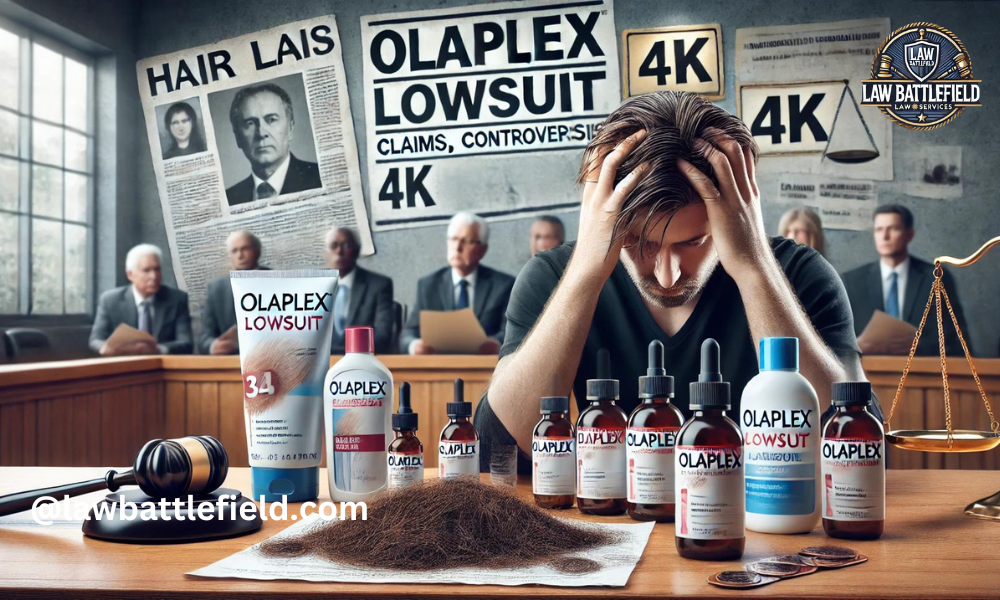Introduction To The Olaplex Lawsuit
Olaplex is a well-known hair care brand popular for its products that promise to repair and strengthen hair. Many people, including celebrities, love Olaplex for its ability to restore damaged hair. The brand’s products, especially the Olaplex No. 3 Hair Perfector, are sold every few seconds worldwide, showing how widely trusted and used they are.
However, recent lawsuits have put Olaplex in the spotlight for less positive reasons. Some customers have filed lawsuits against the company, claiming that Olaplex products caused significant hair and scalp damage. They allege that instead of making hair healthier, the products led to issues like hair loss, dryness, scalp irritation, and even bald patches. This has sparked concern among users who trusted Olaplex to care for their hair.
The lawsuits state that Olaplex products contain ingredients known to cause allergic reactions or other negative effects. One ingredient mentioned is Lilial, a fragrance component that was banned in the European Union due to concerns about reproductive health. Although Olaplex has since removed Lilial from its products, the lawsuits claim that the damage was already done for many users.
Olaplex has strongly denied these allegations, stating that their products are safe and have undergone thorough testing. They argue that independent tests, such as the Human Repeat Insult Patch Tests (HRIPT), showed no evidence of hair loss or irritation caused by their products. Despite these claims, the lawsuits have continued, with many customers seeking compensation for the harm they believe was caused by Olaplex.
This controversy has raised questions about product safety and trust. It also highlights the importance of understanding what goes into hair care products and how they might affect individuals differently. As the legal battles unfold, both Olaplex and its users are watching closely to see what the future holds.
Background Of The Lawsuit
In February 2023, a lawsuit was filed against Olaplex in the Central District federal court of California. The lawsuit involves more than 100 customers who claim that Olaplex products caused severe hair and scalp issues. These customers reported experiencing hair loss, scalp irritation, dryness, and other unexpected side effects after using Olaplex products. The plaintiffs allege that Olaplex marketed its products as safe for all hair types, which they argue is not true based on their experiences.
The lawsuit specifically targets Olaplex products from No. 0 to No. 9. According to the claims, instead of repairing and protecting the hair as advertised, these products allegedly led to problems like dry, brittle, and frizzy hair. Some users reported that their hair became unmanageable, with split ends and breakage that left their hair looking unhealthy and unkempt. In some severe cases, users also noticed bald patches or significant thinning of their hair.
The plaintiffs believe that some ingredients in Olaplex products are to blame for these issues. For example, one ingredient called Lilial, which was previously used in Olaplex products, has been linked to negative effects in other contexts. Although Olaplex has removed Lilial from its products, the lawsuit claims that this action came too late for those who had already suffered damage.
Olaplex denies these allegations, insisting that their products are safe and have been thoroughly tested to meet industry standards. They have released test results from independent laboratories showing that their products passed safety tests without causing skin or scalp irritation. However, the plaintiffs argue that their real-world experiences tell a different story, pushing forward with their claims that Olaplex products are responsible for the damage they have faced.
Key Allegations Against Olaplex
The lawsuits against Olaplex include several serious allegations. One of the main claims is that Olaplex products contain harsh chemicals, such as Lilial, which has been linked to scalp irritation and other health concerns. Lilial was commonly used as a fragrance component in many cosmetic products, but it was banned in the European Union due to concerns about its potential impact on reproductive health. Although Olaplex removed Lilial from its products following the ban, plaintiffs argue that the damage had already occurred for many users who experienced hair loss, irritation, and other adverse effects.
Additionally, the lawsuits allege that Olaplex failed to disclose potential risks associated with its products. Customers claim they were not adequately informed about the possibility of hair loss, scalp irritation, and breakage, which they believe resulted from using Olaplex products. This lack of transparency has become a focal point in the lawsuit, with plaintiffs arguing that they would not have used Olaplex products had they known about these risks.
These allegations paint a picture of a brand that, according to the plaintiffs, did not fully live up to its promises of providing safe and effective hair care solutions. The claims suggest that Olaplex’s marketing and product labeling did not adequately warn consumers about potential side effects, leading to unexpected and distressing outcomes for many users.
Olaplex’s Response To The Allegations
In response to the allegations, Olaplex has firmly denied all claims made in the lawsuits. The company maintains that its products are safe and effective, and they emphasize that they have always followed strict safety protocols. Olaplex points to extensive testing, including independent third-party evaluations, to support their position. They highlight that their products passed Human Repeat Insult Patch Tests (HRIPT), which are standard tests designed to assess the potential for skin and scalp irritation. These tests showed no adverse effects, which Olaplex uses to argue that their products are not responsible for the issues reported by plaintiffs.
CEO JuE Wong has publicly defended Olaplex and its products, stating that the company is prepared to vigorously contest the accusations. She emphasized that Olaplex stands by the quality and safety of their products, and she reassured customers that Olaplex products do not cause hair loss or breakage. Wong also highlighted that the company has gone above and beyond industry standards by releasing safety test results to the public, demonstrating their commitment to transparency.
Olaplex has further argued that various factors could contribute to hair loss and scalp irritation, and these issues may not necessarily be linked to their products. They stress that while some users may have had negative experiences, these are not representative of the overall safety and effectiveness of their hair care line. As the legal proceedings continue, Olaplex remains steadfast in its defense, aiming to clear the brand’s name and restore consumer confidence.
Legal Proceedings And Current Status
The legal battle against Olaplex has seen significant developments. Initially filed as a class action with over 100 plaintiffs, the case has been narrowed down to a single lead plaintiff. The court suggested focusing on this one lead case rather than treating it as a broader class action lawsuit. This decision reflects the court’s view that the specific details and injuries of each plaintiff vary too much to be considered collectively. As of now, the lawsuit is still ongoing, with no final ruling or trial date set. Olaplex continues to dispute the allegations, asserting that there is no scientific evidence linking their products to the reported hair loss and scalp damage.
The latest updates indicate that the court has dismissed the claims of all other plaintiffs except the lead plaintiff, who was asked to amend her complaint. However, she later chose to voluntarily withdraw her lawsuit. This has left the case without a clear path forward, and it remains uncertain whether other affected individuals will pursue legal action independently or if a new class action could emerge in the future. The situation continues to evolve, and both Olaplex and the plaintiffs are closely monitoring the legal proceedings.
Expert Opinions And Reactions
Experts, including dermatologists and hair specialists, have weighed in on the Olaplex lawsuit, providing insights into the potential causes of the reported hair and scalp issues. Many experts agree that while Olaplex products have passed standard safety tests like HRIPT, these tests do not necessarily cover all potential reactions, especially with long-term use. Dermatologists suggest that allergic reactions or sensitivities to certain ingredients could develop over time, even if initial tests show no immediate adverse effects.
Some experts highlight that individuals can develop allergies or sensitivities to cosmetic ingredients after repeated exposure, and these reactions may worsen over time. Ingredients such as fragrances, preservatives, or even seemingly harmless components can trigger scalp irritation or hair damage in susceptible individuals. The broader implication is that while a product may pass safety tests under controlled conditions, real-world use can lead to different outcomes, as seen with the plaintiffs in the Olaplex lawsuit. This underscores the importance of continuous monitoring and individualized responses to hair care products.
Impact On Olaplex And Its Consumers
The lawsuit has had a noticeable impact on Olaplex’s reputation and the trust it has built with its consumers. The allegations have caused concern among loyal users, some of whom are now questioning the safety of Olaplex products. The public reaction has been mixed, with a significant portion of social media users expressing their disappointment and distrust in Olaplex. Many have shared their personal experiences with hair loss or irritation, amplifying the concerns raised in the lawsuit.
On the other hand, there are also many who continue to support Olaplex, attributing any adverse effects to other factors such as improper use or individual sensitivities. This divide is evident on various online platforms where discussions about Olaplex’s safety are ongoing. Despite the support from some customers, the lawsuit has undeniably affected the brand’s image and could influence its market performance and consumer base moving forward.
What Should Olaplex Users Do?
If you are currently using Olaplex products, it’s important to stay informed about the ongoing lawsuit and be mindful of any changes in your hair or scalp health. Experts suggest that if you are experiencing adverse effects such as hair loss, dryness, or scalp irritation, you should consider stopping the use of Olaplex products immediately. Monitor your hair and scalp for any signs of improvement after discontinuing use. If symptoms persist, consulting a dermatologist or hair specialist can provide personalized advice and potential treatments.
For users who have not experienced any issues, you may choose to continue using Olaplex products but should remain vigilant. Pay close attention to your hair’s condition and be cautious if you notice any new or worsening symptoms. It’s also wise to conduct a patch test with any new product, even if you have been using other Olaplex items without issues. Alternatives to Olaplex are available, and exploring other hair care brands might be a safer option if you are concerned about potential risks.
Future Implications
The ongoing legal proceedings against Olaplex could have several outcomes that might impact the company’s market presence. If the court rules in favor of the plaintiffs, Olaplex may face financial penalties and be required to change its product formulations or labeling. This could lead to a loss of consumer trust and a decline in sales, as potential customers may be wary of using a product associated with hair loss allegations.
On the other hand, if Olaplex successfully defends itself, the company may be able to restore some of its reputation, though the shadow of the lawsuit could linger. Additionally, the high-profile nature of this case could prompt further scrutiny of hair care products industry-wide, potentially leading to more lawsuits or regulatory actions in the future.
New lawsuits could arise if more users come forward with similar complaints, or if regulatory bodies decide to investigate further based on the findings from this case. Olaplex, like other beauty brands, will need to navigate this landscape carefully, prioritizing product safety and transparency to maintain consumer confidence and avoid further legal challenges.
Conclusion
In summary, the Olaplex lawsuit has raised significant concerns about product safety and consumer trust. With over 100 plaintiffs alleging that Olaplex products caused hair loss and scalp irritation, the brand is facing a serious legal and reputational challenge. Olaplex has denied these allegations, pointing to third-party safety tests to support their stance, but the legal battle is far from over.
For current and potential Olaplex users, the key takeaway is to remain informed and vigilant. Understanding the ingredients in your hair care products and how they might affect you is crucial. Consumers should also be aware of their legal rights and the importance of product safety in making informed choices.
As the lawsuit unfolds, it will be important for both the company and its customers to keep an eye on developments. The outcome of this case could have broader implications not just for Olaplex, but for the beauty industry as a whole, highlighting the need for greater transparency and accountability.
Frequently Asked Questions (FAQs)
What Is The Olaplex Lawsuit About?
The Olaplex lawsuit involves allegations by over 100 customers who claim that Olaplex products caused hair loss, scalp irritation, and other adverse effects. The lawsuit contends that Olaplex did not adequately disclose potential risks associated with their products.
Which Olaplex Products Are Mentioned In The Lawsuit?
The lawsuit specifically targets Olaplex products numbered from No. 0 to No. 9. Plaintiffs claim these products led to hair and scalp issues, including hair loss, dryness, and irritation.
What Ingredients In Olaplex Products Are Considered Harmful?
One of the main ingredients under scrutiny is Lilial, a fragrance component that was banned in the European Union due to health concerns. Although Olaplex has removed Lilial from its products, it was still present during the time many plaintiffs experienced issues.
How Has Olaplex Responded To The Allegations?
Olaplex has denied all allegations, asserting that their products are safe and backed by third-party test results. The company has released independent lab test findings, including Human Repeat Insult Patch Tests (HRIPT), which indicated no adverse effects related to their products.
Should I Stop Using Olaplex Products?
If you are experiencing any adverse effects such as hair loss or scalp irritation, it is advisable to stop using Olaplex products and consult a dermatologist. If you have not experienced any issues, you can continue using the products but should monitor your hair and scalp health closely.
What Is The Current Status Of The Lawsuit?
The lawsuit has been narrowed to a single lead plaintiff, and the court dismissed the claims of all other plaintiffs. The case is still ongoing, with no final ruling or trial date set.
Can I Join The Olaplex Lawsuit?
As of now, the class action component of the lawsuit has been dismissed, leaving only individual claims. If you believe you have been affected by Olaplex products, you may need to consult with a legal professional to discuss your options.
Was this article helpful? Check out more on Lawbattlefield.com
Market America Lawsuit: What You Need To Know About The Allegation





